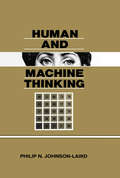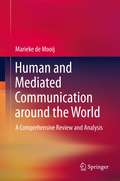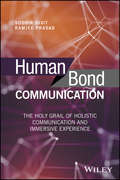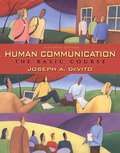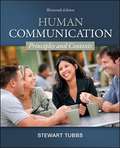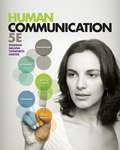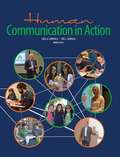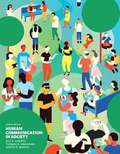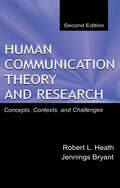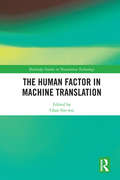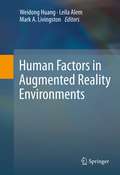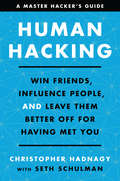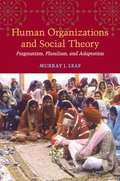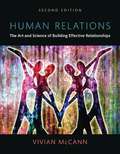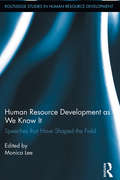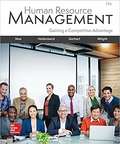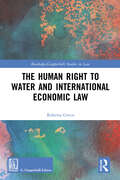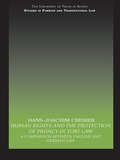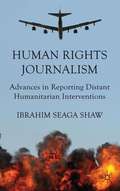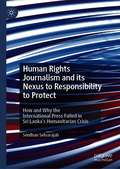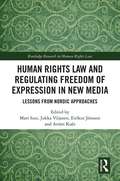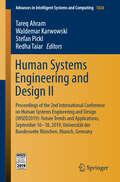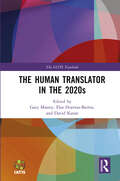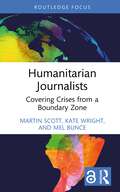- Table View
- List View
Human and Machine Thinking (Distinguished Lecture Series #Vol. 1992)
by Philip N. Johnson-LairdThis book aims to reach an understanding of how the mind carries out three sorts of thinking -- deduction, induction, and creation -- to consider what goes right and what goes wrong, and to explore computational models of these sorts of thinking. Written for students of the mind -- psychologists, computer scientists, philosophers, linguists, and other cognitive scientists -- it also provides general readers with a self-contained account of human and machine thinking. The author presents his point of view, rather than a review, as simply as possible so that no technical background is required. Like the field of research itself, it calls for hard thinking about thinking.
Human and Mediated Communication around the World
by Marieke De MooijThis book is unique in the sense that it offers a comprehensive review and analysis of human communication and mediated communication around the world. This is one of the first attempts to do so in a systematic, comprehensive way. It challenges the assumption that Western theories of human communication and mass communication have universal applicability. It surveys the applicability of mass communication theories to other than Western cultures. The book explains the influence of culture on all forms of communication behavior, be it personal, mediated or mass communication. It presents communication theories from around the world, incorporating a vast body of literature from Europe, Asia, Africa and Latin America. This updated information on important international perspectives that includes both interpersonal and mediated communication is presently not readily available in other sources. The book offers an integrated approach to understanding the working of electronic means of communication that are hybrid media combining human and mediated communication. These new media that are often presented as universal are even more culture-bound than the traditional media.
Human Bond Communication: The Holy Grail of Holistic Communication and Immersive Experience
by Ramjee Prasad Sudhir DixitThis book approaches the topic area of the Internet of Things (IoT) from the perspective of the five types of human communication. Through this perspective on the human communication types, the book aims to specifically address how IoT technologies can support humans and their endeavors. The book explores the fields of sensors, wireless, physiology, biology, wearables, and the Internet. This book is organized with five sections, each covering a central theme; Section 1: The basics of human bond communication Section 2: Relevance IoT, BAN and PAN Section 3: Applications of HBC Section 4: Security, Privacy and Regulatory Challenges Section 5: The Big Picture (Where do we go from here?)
Human Communication: The Basic Course (11th edition)
by Joseph A. DevitoDeVito (Hunter College, City University of New York) looks at the concepts and principles that comprise all forms of communication. Emphasizing public speaking, interpersonal communication, and small group communication, the text is designed for introductory college courses in communication for students with little or no prior background in communication. A new series of boxes presents example speeches and speech outlines with suggestions for critical analysis.
Human Communication: Principles and Contexts
by Stewart TubbsHuman Communication is an introductory text that links theory and research with the practical components of communication. This award-winning author presents the fundamental concepts in communication through stimulating case-studies and contemporary examples. The 13th edition includes new discussions of cutting edge research and additional self-tests for students.
Human Communication (3rd edition)
by Judy C. Pearson Paul E. Nelson Scott Titsworth Lynn HarterTextbook with 3 main sections: Fundamentals of Communication Studies, Communication Contexts, and Fundamentals of Public Speaking: Preparation and Delivery.
Human Communication Fifth Edition
by Lynn Harter Paul Nelson Scott Titsworth Judy PearsonHuman Communication is an integrated program that helps students practice communication skills, build confidence in public speaking, and achieve success in their introductory communication course. With McGraw-Hill LearnSmart in Connect Communication, students separate what they know from what they think they know, following a continually adaptive learning path toward mastery of key concepts. Additionally, Connect provides students with the resources they need to construct well-planned speeches while its highly flexible speech capture tool saves instructors valuable time in managing assignments and evaluating student speeches. Rooted in current scholarship and with an eye on practical, everyday communication scenarios, Human Communication is designed to make introductory communication studies immediate and relevant to students. Following their writing mantra, “Make it Smart. Keep it Real,” the authors strike a balance of definitive theory and everyday application that resonates with the challenges and goals of today's typical basic course.
Human Communication In Action
by Eric Lee Morgan Greg G. ArmfieldHuman Communication In Action by Eric Lee Morgan, Greg G. Armfield
Human Communication In Society
by Jess K. Alberts Thomas K. Nakayama Judith N. MartinHuman Communication in Society takes an enhanced look at the relationship between humans and their societies through a contemporary critical lens. By examining history and societal structures as a means to assess modes of human communication, the text helps readers to understand the theory and context of the way people interact. <p><p> The Fourth Edition uses new examples, illustrations, and pedagogical materials to highlight the importance of understanding multiple perceptions when studying communication. By addressing vital forms of communication such as listening, responding, verbal/non-verbal communication, and perception, Human Communication in Society addresses the subject of interpersonal interaction from a holistic standpoint.
Human Communication Theory and Research: Concepts, Contexts, and Challenges (Routledge Communication Series)
by Robert L. Heath Jennings BryantHuman Communication Theory and Research introduces students to the growing body of theory and research in communication, demonstrating the integration between the communication efforts of interpersonal, organizational, and mediated settings. This second edition builds from the foundation of the original volume to demonstrate the rich array of theories, theoretical connections, and research findings that drive the communication discipline. Robert L. Heath and Jennings Bryant have added a chapter on new communication technologies and have increased depth throughout the volume, particularly in the areas of social meaning, critical theory and cultural studies, and organizational communication. The chapters herein are arranged to provide insight into the breadth of studies unique to communication, acknowledging along the way the contributions of researchers from psychology, political science, and sociology. Heath and Bryant chart developments and linkages within and between ways of looking at communication. The volume establishes an orientation for the social scientific study of communication, discussing principles of research, and outlining the requirements for the development and evaluation of theories. Appropriate for use in communication theory courses at the advanced undergraduate and graduate level, this text offers students insights to understanding the issues and possible answers to the question of what communication is in all forms and contexts.
The Human Factor in Machine Translation (Routledge Studies in Translation Technology)
by Sin-Wai ChanMachine translation has become increasingly popular, especially with the introduction of neural machine translation in major online translation systems. However, despite the rapid advances in machine translation, the role of a human translator remains crucial. As illustrated by the chapters in this book, man-machine interaction is essential in machine translation, localisation, terminology management, and crowdsourcing translation. In fact, the importance of a human translator before, during, and after machine processing, cannot be overemphasised as human intervention is the best way to ensure the translation quality of machine translation. This volume explores the role of a human translator in machine translation from various perspectives, affording a comprehensive look at this topical research area. This book is essential reading for anyone involved in translation studies, machine translation or interested in translation technology.
Human Factors in Augmented Reality Environments
by Leila Alem Mark A Livingston Weidong HuangAdvances in hardware and networking have made possible a wide use of augmented reality (AR) technologies. However, simply putting those hardware and technologies together does not make a "good" system for end users to use. New design principles and evaluation methods specific to this emerging area are urgently needed to keep up with the advance in technologies. Human Factors in Augmented Reality Environments is the first book on human factors in AR, addressing issues related to design, development, evaluation and application of AR systems. Topics include surveys, case studies, evaluation methods and metrics, HCI theories and design principles, human factors and lessons learned and experience obtained from developing, deploying or evaluating AR systems. The contributors for this cutting-edge volume are well-established researchers from diverse disciplines including psychologists, artists, engineers and scientists. Human Factors in Augmented Reality Environments is designed for a professional audience composed of practitioners and researchers working in the field of AR and human-computer interaction. Advanced-level students in computer science and engineering will also find this book useful as a secondary text or reference.
Human Hacking: Win Friends, Influence People, and Leave Them Better Off for Having Met You
by Christopher Hadnagy Seth SchulmanA global security expert draws on psychological insights to help you master the art of social engineering—human hacking. Make friends, influence people, and leave them feeling better for having met you by being more empathetic, generous, and kind.Eroding social conventions, technology, and rapid economic change are making human beings more stressed and socially awkward and isolated than ever. We live in our own bubbles, reluctant to connect, and feeling increasingly powerless, insecure, and apprehensive when communicating with others.A pioneer in the field of social engineering and a master hacker, Christopher Hadnagy specializes in understanding how malicious attackers exploit principles of human communication to access information and resources through manipulation and deceit. Now, he shows you how to use social engineering as a force for good—to help you regain your confidence and control. Human Hacking provides tools that will help you establish rapport with strangers, use body language and verbal cues to your advantage, steer conversations and influence other’s decisions, and protect yourself from manipulators. Ultimately, you’ll become far more self-aware about how you’re presenting yourself—and able to use it to improve your life. Hadnagy includes lessons and interactive “missions”—exercises spread throughout the book to help you learn the skills, practice them, and master them. With Human Hacking, you’ll soon be winning friends, influencing people, and achieving your goals.
Human Organizations and Social Theory: Pragmatism, Pluralism, and Adaptation
by Murray J. LeafIn the 1930s, George Herbert Mead and other leading social scientists established the modern empirical analysis of social interaction and communication, enabling theories of cognitive development, language acquisition, interaction, government, law and legal processes, and the social construction of the self. However, they could not provide a comparably empirical analysis of human organization. The theory in this book fills in the missing analysis of organizations and specifies more precisely the pragmatic analysis of communication with an adaptation of information theory to ordinary unmediated communications. The study also provides the theoretical basis for understanding the success of pragmatically grounded public policies, from the New Deal through the postwar reconstruction of Europe and Japan to the ongoing development of the European Union, in contrast to the persistent failure of positivistic and Marxist policies and programs.
Human Relations: The Art and Science of Building Effective Relationships (Second Edition)
by Vivian McCannFor courses in Adjustment, Interpersonal Behavior, and Human Relations. A conceptual and skills-based overview of relationship building in today’s world. Human Relations: The Art and Science of Building Effective Relationships helps students learn how to communicate more effectively within all of their personal and professional relationships. Employing a three-tiered approach to human relations, author Vivian McCann helps students to understand the psychological concepts that underlie relationships, to build the skills needed to communicate effectively, and to consider the influence of cultural norms and backgrounds throughout the relationship-building process. Revised to reflect the latest data and research, the Second Edition also includes updated information about how new technologies have greatly impacted today’s relationships.
Human Resource Development as We Know It: Speeches that Have Shaped the Field (Routledge Studies in Human Resource Development)
by Monica LeeThe field of Human Resource Development has developed largely through academics, scholars and reflective practitioners from across the world coming together. Many people link memorable keynote speeches to changes in their research, practice, career path or even life view. Good keynote speeches are a forthright statement of the expert’s view and thus are often not published. Now that HRD is maturing there is a need to recapture some of those earlier moments – both as a form of archive, and also to shed light on the path that has been followed. Twenty-two speeches seminal to the field of HRD are included in this volume. These speeches are milestones along the path of the development of the field; as well as reconstructing their speech, the contributors have also located it within the time it was given and commented on how the field has developed since. This book is a resource, not only as an archive and for those who wish to relive their pivotal moments, but also for anyone interested in the development of HRD as a discipline. This unique approach provides an exciting and engaging way to reflect on cutting edge issues in the academic and practitioner world of HRD!
Human Resource Management: Gaining a Competitive Advantage
by Raymond Noe Barry Gerhart Patrick Wright John HollenbeckHuman Resource Management: Gaining a Competitive Advantage was developed to teach students how to strategically overcome challenges within organizations and gain a competitive advantage for their companies. All of the authors have won numerous teaching and prestigious research awards; this along with their teamwork and consulting experience delivers a learning program strong is depth and breadth and current in research and practice simply not found in other products.
The Human Right to Water and International Economic Law (Routledge-Giappichelli Studies in Law)
by Roberta GrecoThis book discusses the international right to water and the liberalization of water services. It is concerned with the harmonization of the right to water with the legal systems under which liberalization of water services has taken or may take place. It assesses paths of harmonization between international human rights law and international economic law in this specific field. The issue of the compatibility between the fulfilment of the right to water and the liberalization of water services has been at the heart of a passionate public debate between opponents and advocates of the privatization of the utility. The book provides an unbiased analysis of different international legal regimes under which the liberalization of water services has occurred or is likely to occur, notably international investment law, international trade law and European Union law, in order to assess whether the main features of the right to water can be guaranteed under each of these systems of law and whether there is space for prospective harmonization. The work will be an invaluable resource for academics, researchers and policy-makers working in the areas of International Human Rights Law, International Economic Law, International Water Law, International Trade Law and EU Law.
Human Rights and the Protection of Privacy in Tort Law: A Comparison between English and German Law (UT Austin Studies in Foreign and Transnational Law)
by Hans-Joachim CremerIn its case law, the European Court of Human Rights has acknowledged that national courts are bound to give effect to Article 8 of the European Convention of Human Rights (ECHR) which sets out the right to private and family life, when they rule on controversies between private individuals. Article 8 of the ECHR has thus been accorded mittelbare Drittwirkung or indirect ‘third-party’ effect in private law relationships. The German law of privacy, centring on the "allgemeines Persönlichkeitsrecht", has quite a long history, and the influence of the European Court of Human Rights’ interpretation of the ECHR has led to a strengthening of privacy protection in the German law. This book considers how English courts could possibly use and adapt structures adopted by the German legal order in response to rulings from the European Court of Human Rights, to strengthen the protection of privacy in the private sphere.
Human Rights Journalism
by Ibrahim Seaga ShawShaw argues that journalism should focus on deconstructing the underlying structural and cultural causes of political violence such as poverty, famineandhuman trafficking, and play a proactive (preventative), rather than reactive (prescriptive) role in humanitarian intervention. "
Human Rights Journalism and its Nexus to Responsibility to Protect: How and Why the International Press Failed in Sri Lanka’s Humanitarian Crisis
by Senthan SelvarajahThis book takes a holistic approach by capturing the various perspectives and viewpoints concerning the theory and practice of Human Rights Journalism. Firstly, this book helps fill the epistemological vacuum present in Human Rights Journalism by proposing ‘pragmatic objectivity’ within the critical constructivist epistemology. Secondly, it defines the Human Rights Journalism-Responsibility to Protect nexus by identifying five key elements. Thirdly, it proposes a Human Rights Journalism-Responsibility to Protect conceptual model, which illustrates how an embedded human rights focussed media strategy can be designed. Fourthly, this book proposes two novel quantitative analysis tools called the ‘Framing Matrix’ and the ‘Multimodal Discourse Analysis Matrix’ that are equipped to deal with a big sample size over a long period of time. These tools are used to examine the practice of Human Rights Journalism and the typology of news stories of distant sufferings. Finally, it provides a scientific explanation for those in search of the answer to why one of the worst humanitarian crises in the world, which took place in Sri Lanka in 2009, did not create any global compassion or garner attention.
Human Rights Law and Regulating Freedom of Expression in New Media: Lessons from Nordic Approaches (Routledge Research in Human Rights Law)
by Mart Susi Jukka Viljanen Eiríkur Jónsson Artūrs KučsThe Nordic countries are well known globally for their high human rights standards and, at the same time, high degree of internet freedom. This edited collection reveals how the Nordic countries have succeeded in the task of protecting freedom of expression in the new media. It contains an overview of public policy choices and best practices of domestic online companies, which have the aspiration of finding global acceptance. Reviewing the topic of freedom of expression in new media within Nordic and Baltic countries, this book incorporates both general themes and interesting country-specific themes that will provide wider knowledge on the development of freedom of expression and media law in the online media era. A comprehensive analysis of regulation of online media, both at the level of legislation and application of law in courts and other authorities, are included. This book will contribute to the ongoing discussion as to whether there is a need to modify prevailing interpretation of freedom of expression. Human Rights Law and Regulating Freedom of Expression in New Media focuses on the multi-layered and complicated relationship between internet and human rights law. It contributes to the ongoing discussion regarding the protection of freedom of expression on the internet in the context of various doctrines of constitutional law, including the proliferation of constitutional adjudication. It will be of interest to researchers, academics, policymakers, and students in the fields of human rights law, internet law, political science, sociology, cultural studies, media and communications studies and technology.
Human Systems Engineering and Design II: Proceedings of the 2nd International Conference on Human Systems Engineering and Design (IHSED2019): Future Trends and Applications, September 16-18, 2019, Universität der Bundeswehr München, Munich, Germany (Advances in Intelligent Systems and Computing #1026)
by Tareq Ahram Waldemar Karwowski Stefan Pickl Redha TaiarThis book focuses on novel design and systems engineering approaches, including theories and best practices, for promoting a better integration of people and engineering systems. It covers a range of hot topics related to: development of human-centered systems; interface design and human-computer interaction; usability and user experience; emergent properties of human behavior; innovative materials in manufacturing, biomechanics, and sports medicine, safety engineering and systems complexity business analytics, design and technology and many more. The book, which gathers selected papers presented at the 2nd International Conference on Human Systems Engineering and Design: Future Trends and Applications (IHSED 2019), held on September 16-18, 2019, at Universität der Bundeswehr München, Munich, Germany, provides researchers, practitioners and program managers with a snapshot of the state-of-the-art and current challenges in the field of human systems engineering and design.
The Human Translator in the 2020s (The IATIS Yearbook)
by Gary Massey Elsa Huertas-Barros David KatanHas the language industry of the 21st century been racing ahead of the translation profession and leaving translators behind? Or are translators adapting to new sociotechnical realities and societal demands, and if so, how? The chapters in this volume seek to shed light on the profiles and position of human translators in the current decade. This collection draws together the work of leading authors to reflect on the constantly evolving language industry. The eight chapters present new perspectives on, and concepts of, translation in a digital world. They highlight the shifts taking place in the sociotechnical environment of translation and the need to address changing buyer needs and market demands with new services, profiles and training. In doing so, they share a common focus on the added value that human translators can and do bring to bear as adaptive, creative, digitally literate experts. Addressing an international readership, this volume is of interest to advanced students and researchers in translation and interpreting studies, and professionals in the global language industry.
Humanitarian Journalists: Covering Crises from a Boundary Zone (Routledge Focus on Journalism Studies)
by Martin Scott Kate Wright Mel BunceThis book documents the unique reporting practices of humanitarian journalists – an influential group of journalists defying conventional approaches to covering humanitarian crises. Based on a 5-year study, involving over 150 in-depth interviews, this book examines the political, economic and social forces that sustain and influence humanitarian journalists. The authors argue that – by amplifying marginalised voices and providing critical, in-depth explanations of neglected crises – these journalists show us that another kind of humanitarian journalism is possible. However, the authors also reveal the heavy price these reporters pay for deviating from conventional journalistic norms. Their peripheral position at the ‘boundary zone’ between the journalistic and humanitarian fields means that a humanitarian journalist’s job is often precarious – with direct implications for their work, especially as ‘watchdogs’ for the aid sector. As a result, they urgently need more support if they are to continue to do this work and promote more effective and accountable humanitarian action. A rigorous study of how unique professional practices can be produced at the ‘boundary zone’ between fields, this book will interest students and scholars of journalism and communication studies, sociology and humanitarian studies. It will also appeal to those interested in studies of news and media work as occupational identities.
